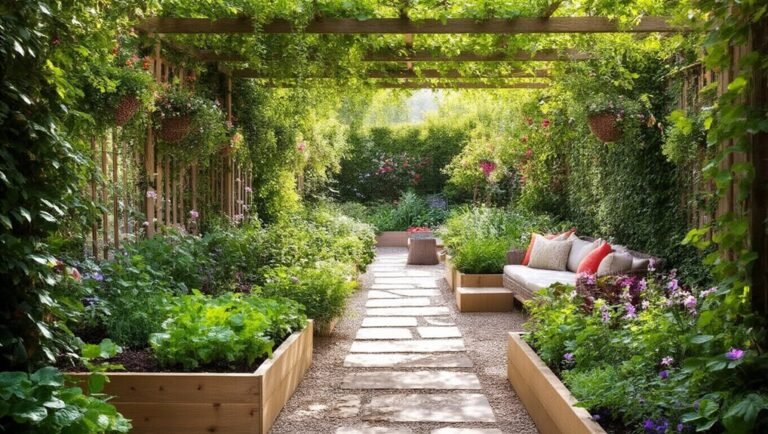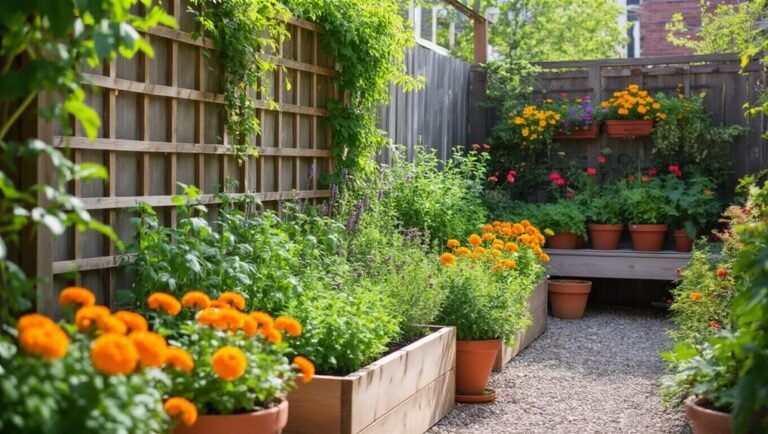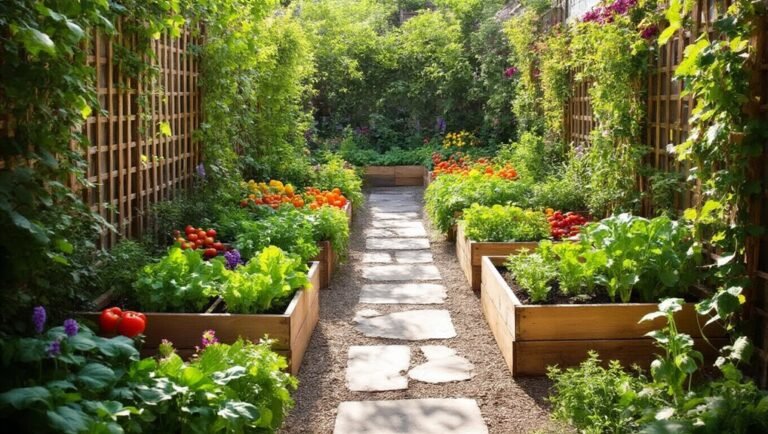To grow full-sized onions in containers, start by choosing pots at least 12 inches deep with good drainage. Select the right onion varieties based on your climate—short, intermediate, or long-day onions. Prepare a nutrient-rich soil mix, and plant onion sets 2-4 inches apart, ensuring they’re positioned correctly. Water regularly and monitor for pests. Harvest when the tops yellow, and store them properly for future use. For more tips on successful onion cultivation, keep exploring!
Key Takeaways
- Choose containers that are at least 12 inches deep with good drainage holes for optimal bulb development.
- Select the right onion variety based on your climate: short-day for warm regions, long-day for northern areas.
- Prepare soil by mixing high-quality potting soil with organic matter and maintaining a pH of 6.0 to 6.8.
- Plant onion sets or seedlings 2-4 inches apart in nutrient-rich soil, ensuring they receive full sunlight.
- Water consistently, aiming for about an inch per week, and monitor for pests and diseases to maintain plant health.
Choosing the Right Container
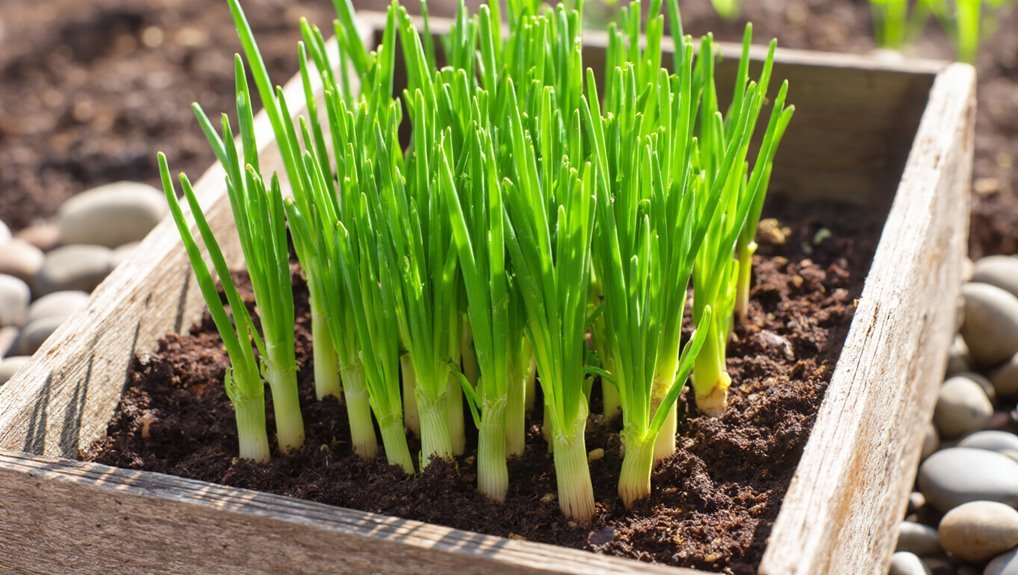
When it comes to growing onions in containers, choosing the right one is crucial for their success. Opt for containers that are at least 12 inches deep; this gives the onions enough room to develop their bulbs.
You’ll want to ensure they’ve good drainage, so look for pots with holes at the bottom. Materials like plastic or clay work well, but make sure they’re lightweight if you plan to move them around. Using essential garden hose connectors can help you easily attach watering devices to your hose for more efficient care of your container garden.
Consider the size as well; a larger container can hold multiple onions, allowing for better yields. Additionally, if you’re in a warmer climate, a container with light colors can help regulate the temperature.
For watering, using garden hoses designed for gentle and even water distribution makes it easier to keep your onion plants healthy in containers.
With the right container, you’re setting the stage for healthy onion growth.
Selecting the Best Onion Varieties
As you consider which onion varieties to grow, it’s important to choose ones that suit your climate and taste preferences.
There are three main types: short-day, intermediate, and long-day onions. If you live in warmer regions, opt for short-day varieties, as they mature with fewer daylight hours. For those in northern climates, long-day onions thrive with extended daylight. Intermediate varieties can adapt to both conditions. For the healthiest growth, make sure to provide your onions with plant fertilizer tablets to boost their nutrient intake.
Think about the flavors you enjoy, too. Sweet onions, like Vidalia, are perfect for raw dishes, while pungent varieties, like yellow onions, work well in cooking.
Don’t forget to check local gardening resources for recommendations tailored to your area. Choosing the right variety will set you up for a successful onion harvest!
For more in-depth guidance, consult gardening books that cover essential reads for every gardening enthusiast.
Preparing the Soil for Optimal Growth
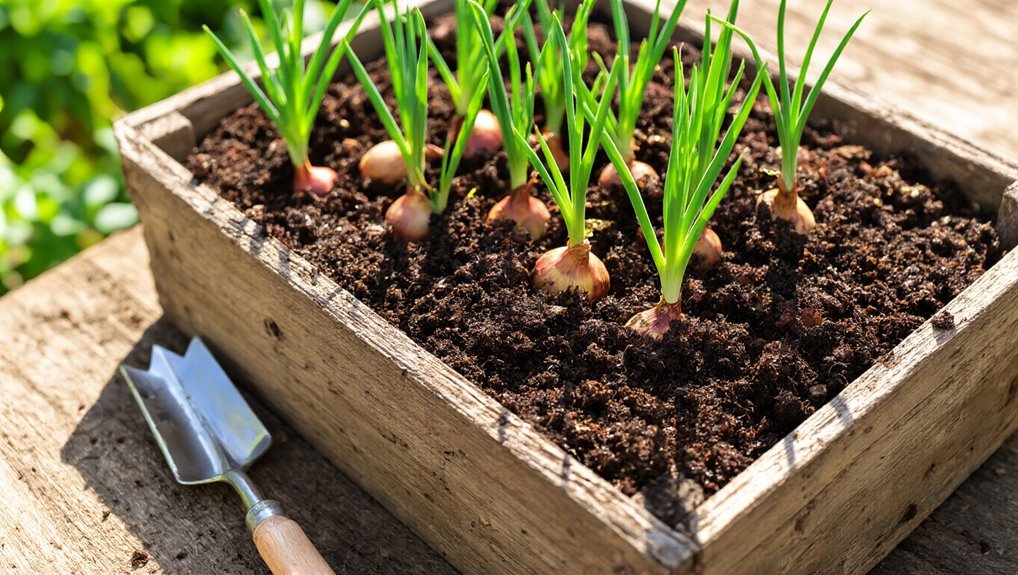
Selecting the right onion varieties is just the beginning; preparing the soil properly is key to growing healthy onions in containers. Start by mixing high-quality potting soil with essential nutrients. This ensures your onions have the best foundation for growth. Using mulch is also beneficial for helping the soil retain moisture and suppressing weeds in your garden.
Consider these soil preparation steps:
- Add organic matter: Incorporate compost or well-rotted manure to improve soil structure and fertility.
- Check drainage: Ensure the soil drains well to prevent waterlogging, which can lead to rot.
- Adjust pH: Aim for a pH of 6.0 to 6.8 for optimal nutrient absorption; you can test and amend the soil if necessary.
For even healthier soil and moisture retention, consider using organic mulching materials such as straw on top of your container soil.
Planting Onions in Containers
Once you’ve prepared the soil, it’s time to plant your onions in containers for a bountiful harvest.
Begin by selecting onion sets or seedlings suited for your climate. Fill your container with the nutrient-rich soil you prepared, leaving about an inch of space at the top.
Plant the onion sets about 2-4 inches apart, ensuring the pointed end faces up. If you’re using seedlings, transplant them at the same depth they were growing in their nursery containers. Using gardening tool sets can help ensure you have everything you need for efficient and comfortable planting.
Water the soil gently to settle it around the bulbs but avoid overwatering. Position your containers in a sunny spot, as onions thrive in full sunlight.
To make the planting process easier and more precise, consider using a garden trowel when placing onion sets or seedlings into the soil.
With these steps, you’re on your way to growing delicious onions right at home!
Care and Maintenance for Healthy Onions
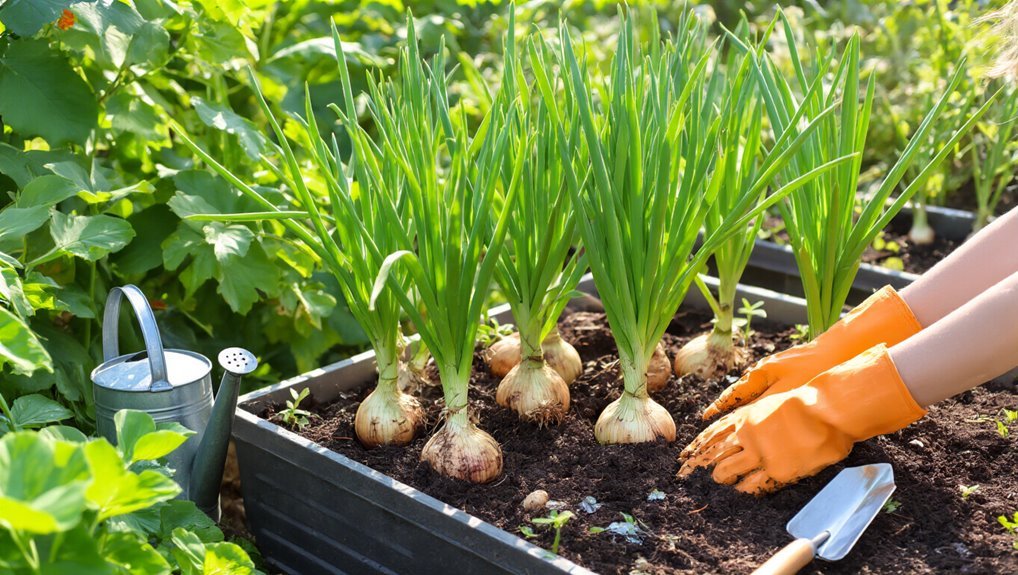
To ensure your onions thrive, you’ll need to provide consistent care and maintenance throughout their growing season.
Start by watering them regularly, keeping the soil moist but not soggy. Onions require about an inch of water per week, so adjust based on your climate.
Next, keep an eye on pests and diseases. Regularly inspect your plants for any signs of trouble, like yellowing leaves or unusual spots.
Finally, feed your onions with a balanced fertilizer every few weeks to promote healthy growth.
- Water consistently, aiming for about an inch per week.
- Inspect regularly for pests and disease.
- Fertilize every few weeks with a balanced mix.
With these practices, your onions will be on their way to healthy growth!
Harvesting and Storing Your Onions
Knowing when and how to harvest your onions is crucial for enjoying their full flavor and ensuring a good shelf life.
You’ll know it’s time to harvest when the tops start to yellow and fall over. Gently loosen the soil around the bulbs with a garden fork, being careful not to damage them. Pull the onions out and let them cure in a dry, airy spot for a few days.
Once the outer skins are dry and papery, trim the roots and tops to about an inch. For storage, place your onions in a cool, dark, and well-ventilated area. Avoid plastic bags; instead, use mesh bags or baskets to keep them fresh longer.
Enjoy your homegrown onions!
Frequently Asked Questions
Can I Grow Onions Indoors in Containers?
Yes, you can grow onions indoors in containers. Choose a suitable pot, use quality potting soil, and ensure they get enough light. Water them regularly, and you’ll enjoy fresh onions right from your home!
How Deep Should the Container Be for Onions?
Imagine a wise tree needing deep roots. For your onions, choose a container at least 12 inches deep. This depth allows them to spread their roots, gathering nutrients and water, ensuring healthy growth and bountiful harvests.
Do Onions Need Direct Sunlight to Grow?
Yes, onions need direct sunlight to grow well. Aim for at least six hours of sunlight each day. Without sufficient light, they won’t develop properly, leading to smaller bulbs and less flavorful onions.
Can I Use Leftover Onion Sets for Planting?
Yes, you can use leftover onion sets for planting. Just make sure they’re still firm and healthy. Plant them in well-draining soil, and you’ll likely enjoy a good harvest from those leftover sets!
What Pests Should I Watch for When Growing Onions?
You should watch for onion flies, thrips, and aphids when growing onions. Regularly inspecting your plants helps you catch infestations early. Using row covers can also protect your onions from these pesky pests.
Conclusion
By now, you’ve got the know-how to grow full-sized onions in containers like a pro. With the right container, soil, and care, you’ll be harvesting your homegrown onions in no time—no need to hit the farmer’s market! Remember to keep a close eye on their needs, and soon enough, you’ll have a bountiful crop ready to spice up your meals. So get out there and channel your inner garden wizard; those onions won’t grow themselves!
